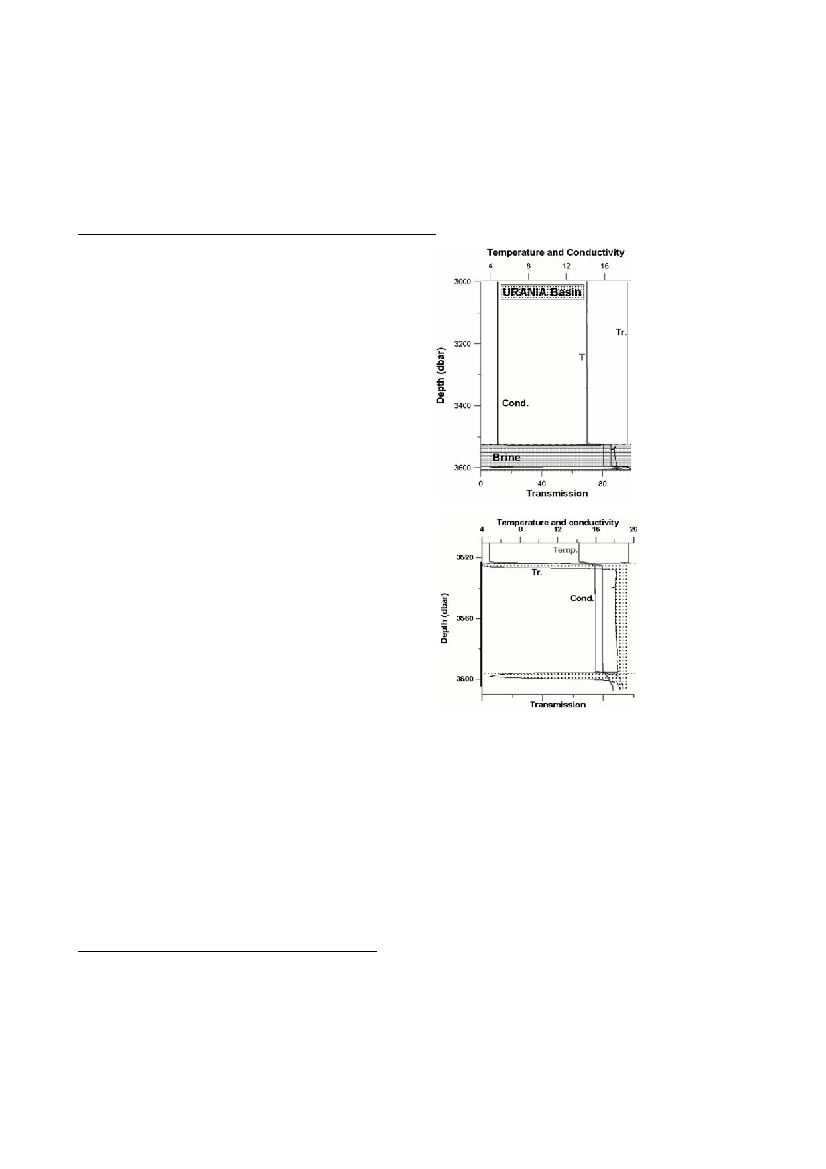Rapp. Comm. int. Mer Médit., 36,2001
16
During the last few years an increasing number of deep brine lakes
has been discovered in the eastern Mediterranean and characterized in
successful EU projects such as P
ALAEOFLUX
, M
EDRIFF
, SAP, and
B
IODEEP
, and the French-Dutch M
EDINAUT
programme.
These anoxic hypersaline deep basins are amongst the most extreme
environments found in the deep Mediterranean, with one of the high-
est dissolved sulphide concentrations ever reported for the ‘open
marine’environment (upto more than 12 mM), and demonstrating
large compositional differences between different brine pools: going
from a nearly 5 M MgCl2 solution and below seawater Na content
(Discovery Basin) to a nearly saturated 5.3 M NaCl solution (Tyro
Basin). The recently discovered Nadir brine has a high conductivity, is
high in NaCl, methane, and possibly sulphide, is relatively shallow
(2088 dbar compared to > 3200 dbar for al other brines) and seems
rather ‘recent’.
One of the most extreme environments thusfar discovered is Urania
Basin which contains the highest radiogenic supersaturations ever
observed for the marine environment (
3
He /
4
He of 1.10
-7
and
40
Ar /
36
Ar of 470; ref. 1), the most extreme d11B (28%o; ref. 2), the high-
est methane content (> 260 ul/ml), and the highest bottomwater tem-
perature (> 48°C). Irregular methane-driven (?) mud-eruptions appear
to occur from the latter bottom at least upto 600 m above the basin-
?oor, i.e. to a waterdepth of 2900 m.
The composition of most of the brines seems to relate to a ‘relict
brine’or the dissolution of evaporites both originating from the
Messinian period during which the Mediterranean is thought to have
been dessicated (Bannock, Atalante and Tyro Basins). On the basis of
various isotopes for most of these basins the 'relic brine' option seems
the most plausible. In addition, the compositions of relevant major and
minor elements appear to be in near coincidence with the theoretical
seawater evaporation path.
Urania brine is the most extreme exception to this picture, its major
and minor element composition, but in particular its isotopic signature
clearly relates to a source area that must be much deeper than that of
the Messinian evaporites, and which is clearly in?uenced by high-tem-
perature interactions with old sediment and volcanic (ash layers ?)
units.
In addition to their individual compositional characteristics, each
brine demonstrates a typical and for most of them rather stable inter-
nal brine structure of various different brine levels. Subtle as well as
outspoken temperature and compositional differences occur between
the different brine levels in individual basins. The transition between
different brine levels, and between brine and seawater may be rela-
tively gradual but usually is extremely abrupt (Fig. 1; see also ref. 3).
In particular the seawater/brine transition is dramatically changing
from seawater to 10x seawater concentration within a depth interval of
100 cm. The interface is further characterized by a strong dip in
Transmission (= high suspended matter content, but possibly partly
related to re?ections while waters of different densities are mixed; Fig.
2). Not only redox-related changes occur at these abrupt interfaces
(ref. 3,4), but also the distinct presence of specialized bacterial com-
munities are hypothesized, resulting in bacterial mats. These latter
have thus far been encountered in the underlying brine sediments only,
usually at the base of a slump deposit, suggesting their entrainment
upon entering the brine.
(*) Results have been obtained during EU projects MEDRIFF, PAELE-
OFLUX, SAP, BIODEEP, during French/Dutch bilateral project MEDINAUT,
during MEDMUD and PASS2 projects, and are ongoing during BIODEEP.
References
1.Winckler G., Suess E., Wallmann K., De Lange G.J., Westbrook G.,
and Bayer R., 1997. Excess Helium and Argon of radiogenic origin in
Mediterranean brine basins.Earth Planet. Sci. Lett.,151: 225-231.
2.Vengosh A., De Lange G.J., and StarinskyA., 1998. Boron isotope and
geochemical evidence for the origin of Urania and Bannock brines at the
eastern Mediterranean: Effect of water-rock interactions. Geochim.
Cosmochim. Acta,62: 3221-3228.
3. De Lange G.J., Catalano G., Klinkhammer G.P. and Luther G.W.,
1990. The interface between oxic seawater and the anoxic Bannock
Brine; its sharpness and the consequneces for the redox-related cycling of
Mn and Ba. Mar. Chem., 31: 205-217.
4. De Lange G.J., Boelruk N.A.I.M., Catalano G., Corselli C.,
Klinkhammer G.P., Middelburg J.J., Müller D.W., Ullman W.J.,Van
Gaans P. and Woittiez J.R.W., 1990. Sulphate-related equilibria in the
hypersaline brines of the Tyro and Bannock basins, eastern
Mediterranean.Mar. Chem.,31: 89-112.
5. Erba E., 1991. Deep mid-water bacterial mats from anoxic basins of
the Eastern Mediterranean. Mar. Geol., 100: 83-101.
HYPERSALINE EASTERN MEDITERANEAN BRINES: COMPOSITION AND ORIGIN (*)
Gert J. De Lange
1*
,Van Santvoort P.
1
, Passier H.
1
, Rutten A.
1
,Vengosh A.
2
, Michard A.
3
, Corselli C.
4
,Winckler G.
5
,
Wallmann K.
6
, Suess E.
6
, J. Woodside
7
, J.P. Foucher
8
, and M
EDINAUT
participants.
1
Faculty of Earth Sciences, Depart. of Geochemistry and of Palemagnetist, Utrecht Univ, the Netherlands - gdelange@geo.uu.nl
2
Hydrological Service, Research department, Jerusalem, Israel
3
Centre de Recherches de Geosciences, CEREGE, Aix-en-Provence , France.
4
University of Milano-2, Department of Geological sciences and Geotechnologies, Milano, Italy
5
University Heidelberg,Institute for Environmental physics, Heidelberg, Germany
6
Geomar Research Centre for Marine Geosciences at C. Albrechts University, Kiel, Germany
7
University of Amsterdam, department of Marine Geology,Amsterdam, The Netherlands
8
Ifremer, Centre for Marine Research, Plouzane-Brest, France
Keywords: Eastern Mediterranean, brines, hydrothermal, geochemistry
Fig. 1 -Temperature,
conductivity and
transmissionversus
depth below 3000
dbar for Urania
basin.Note the low
transmission at
seawater/brine and
brine I /brinne II
Fig. 2 - Detailed
graph of
temperature,
conductivity and
transmissionversus
depth below 3510
dbar for Urania
basin.Transmission
values below normal
seawater values are
indicated in grey;

